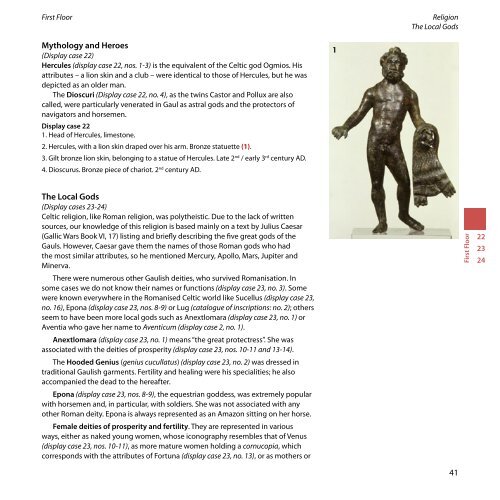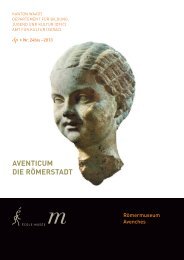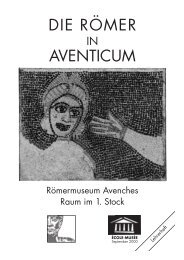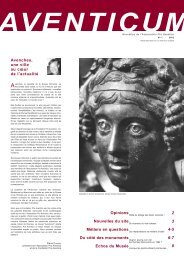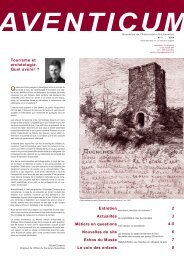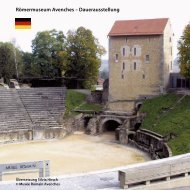Avenches – Roman Museum – Permanent Exhibition
Avenches – Roman Museum – Permanent Exhibition
Avenches – Roman Museum – Permanent Exhibition
You also want an ePaper? Increase the reach of your titles
YUMPU automatically turns print PDFs into web optimized ePapers that Google loves.
First Floor Religion<br />
The Local Gods<br />
Mythology and Heroes<br />
(Display case 22)<br />
Hercules (display case 22, nos. 1-3) is the equivalent of the Celtic god Ogmios. His<br />
attributes <strong>–</strong> a lion skin and a club <strong>–</strong> were identical to those of Hercules, but he was<br />
depicted as an older man.<br />
The Dioscuri (Display case 22, no. 4), as the twins Castor and Pollux are also<br />
called, were particularly venerated in Gaul as astral gods and the protectors of<br />
navigators and horsemen.<br />
Display case 22<br />
1. Head of Hercules, limestone.<br />
2. Hercules, with a lion skin draped over his arm. Bronze statuette (1).<br />
3. Gilt bronze lion skin, belonging to a statue of Hercules. Late 2nd / early 3rd century AD.<br />
4. Dioscurus. Bronze piece of chariot. 2nd century AD.<br />
The Local Gods<br />
(Display cases 23-24)<br />
Celtic religion, like <strong>Roman</strong> religion, was polytheistic. Due to the lack of written<br />
sources, our knowledge of this religion is based mainly on a text by Julius Caesar<br />
(Gallic Wars Book VI, 17) listing and briefly describing the five great gods of the<br />
Gauls. However, Caesar gave them the names of those <strong>Roman</strong> gods who had<br />
the most similar attributes, so he mentioned Mercury, Apollo, Mars, Jupiter and<br />
Minerva.<br />
There were numerous other Gaulish deities, who survived <strong>Roman</strong>isation. In<br />
some cases we do not know their names or functions (display case 23, no. 3). Some<br />
were known everywhere in the <strong>Roman</strong>ised Celtic world like Sucellus (display case 23,<br />
no. 16), Epona (display case 23, nos. 8-9) or Lug (catalogue of inscriptions: no. 2); others<br />
seem to have been more local gods such as Anextlomara (display case 23, no. 1) or<br />
Aventia who gave her name to Aventicum (display case 2, no. 1).<br />
Anextlomara (display case 23, no. 1) means “the great protectress”. She was<br />
associated with the deities of prosperity (display case 23, nos. 10-11 and 13-14).<br />
The Hooded Genius (genius cucullatus) (display case 23, no. 2) was dressed in<br />
traditional Gaulish garments. Fertility and healing were his specialities; he also<br />
accompanied the dead to the hereafter.<br />
Epona (display case 23, nos. 8-9), the equestrian goddess, was extremely popular<br />
with horsemen and, in particular, with soldiers. She was not associated with any<br />
other <strong>Roman</strong> deity. Epona is always represented as an Amazon sitting on her horse.<br />
Female deities of prosperity and fertility. They are represented in various<br />
ways, either as naked young women, whose iconography resembles that of Venus<br />
(display case 23, nos. 10-11), as more mature women holding a cornucopia, which<br />
corresponds with the attributes of Fortuna (display case 23, no. 13), or as mothers or<br />
1<br />
41<br />
First Floor<br />
22<br />
23<br />
24


